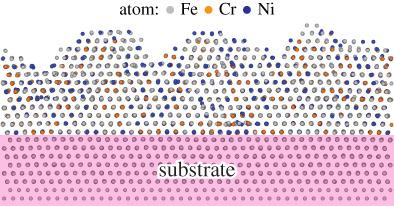当前位置:
X-MOL 学术
›
J. Comput. Chem.
›
论文详情
Our official English website, www.x-mol.net, welcomes your
feedback! (Note: you will need to create a separate account there.)
An Fe-Ni-Cr embedded atom method potential for austenitic and ferritic systems
Journal of Computational Chemistry ( IF 3.4 ) Pub Date : 2018-10-31 , DOI: 10.1002/jcc.25573 Xiaowang W. Zhou 1 , Michael E. Foster 1 , Ryan B. Sills 1
Journal of Computational Chemistry ( IF 3.4 ) Pub Date : 2018-10-31 , DOI: 10.1002/jcc.25573 Xiaowang W. Zhou 1 , Michael E. Foster 1 , Ryan B. Sills 1
Affiliation

|
Fe‐Ni‐Cr stainless‐steels are important structural materials because of their superior strength and corrosion resistance. Atomistic studies of mechanical properties of stainless‐steels, however, have been limited by the lack of high‐fidelity interatomic potentials. Here using density functional theory as a guide, we have developed a new Fe‐Ni‐Cr embedded atom method potential. We demonstrate that our potential enables stable molecular dynamics simulations of stainless‐steel alloys at high temperatures, accurately reproduces the stacking fault energy—known to strongly influence the mode of plastic deformation (e.g., twinning vs. dislocation glide vs. cross‐slip)—of these alloys over a range of compositions, and gives reasonable elastic constants, energies, and volumes for various compositions. The latter are pertinent for determining short‐range order and solute strengthening effects. Our results suggest that our potential is suitable for studying mechanical properties of austenitic and ferritic stainless‐steels which have vast implementation in the scientific and industrial communities. Published 2018. This article is a U.S. Government work and is in the public domain in the USA.
中文翻译:

奥氏体和铁素体系统的 Fe-Ni-Cr 嵌入原子方法潜力
Fe-Ni-Cr不锈钢因其优异的强度和耐腐蚀性成为重要的结构材料。然而,不锈钢机械性能的原子研究由于缺乏高保真原子间势而受到限制。在此以密度泛函理论为指导,我们开发了一种新的 Fe-Ni-Cr 嵌入原子方法势。我们证明了我们的潜力能够在高温下对不锈钢合金进行稳定的分子动力学模拟,准确地再现层错能——已知会强烈影响塑性变形模式(例如,孪晶与位错滑动与交叉滑动)——这些合金在一系列成分上的分布,并为各种成分提供了合理的弹性常数、能量和体积。后者与确定短程有序和溶质强化效应有关。我们的结果表明,我们的潜力适用于研究奥氏体和铁素体不锈钢的机械性能,这在科学和工业界具有广泛的应用。2018 年发表。本文为美国政府作品,在美国属于公有领域。
更新日期:2018-10-31
中文翻译:

奥氏体和铁素体系统的 Fe-Ni-Cr 嵌入原子方法潜力
Fe-Ni-Cr不锈钢因其优异的强度和耐腐蚀性成为重要的结构材料。然而,不锈钢机械性能的原子研究由于缺乏高保真原子间势而受到限制。在此以密度泛函理论为指导,我们开发了一种新的 Fe-Ni-Cr 嵌入原子方法势。我们证明了我们的潜力能够在高温下对不锈钢合金进行稳定的分子动力学模拟,准确地再现层错能——已知会强烈影响塑性变形模式(例如,孪晶与位错滑动与交叉滑动)——这些合金在一系列成分上的分布,并为各种成分提供了合理的弹性常数、能量和体积。后者与确定短程有序和溶质强化效应有关。我们的结果表明,我们的潜力适用于研究奥氏体和铁素体不锈钢的机械性能,这在科学和工业界具有广泛的应用。2018 年发表。本文为美国政府作品,在美国属于公有领域。











































 京公网安备 11010802027423号
京公网安备 11010802027423号